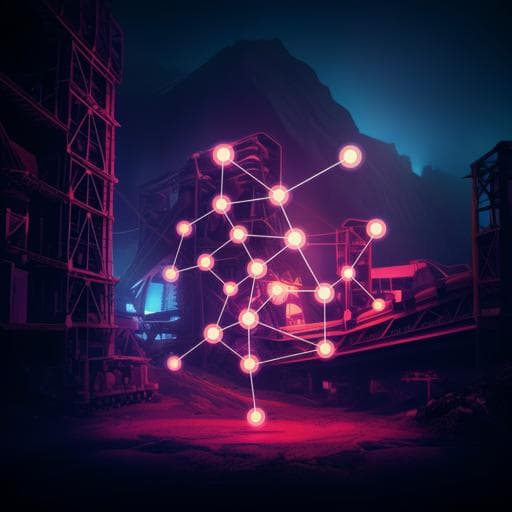
Engineering and Technology
Autonomous mining through cooperative driving and operations enabled by parallel intelligence
L. Chen, Y. Xie, et al.
Discover an innovative autonomous mining framework developed by Long Chen, Yuting Xie, Yuhang He, Yunfeng Ai, Bin Tian, Lingxi Li, Shirong Ge, and Fei-Yue Wang. Utilizing self-evolving digital twins and virtual mining subsystems, this research has shown impressive results by enhancing safety and productivity across 30 mines and extracting over 30 million tons of minerals.
~3 min • Beginner • English
Introduction
The paper addresses how to achieve fully autonomous, safe, and efficient mining operations at scale. Traditional mining faces harsh conditions, labor shortages, safety risks, and rising demand for minerals, motivating automation to increase productivity and safety while reducing environmental impact. Prior efforts have partially automated subsystems (e.g., autonomous trucks, remote excavation, drilling/blasting, rescue robots, 3D modeling), but fall short of integrated, scalable autonomy in large, heterogeneous, complex mines. The authors identify three key challenges: (1) generalization in unstructured, adverse field environments with uneven terrain, dust, and diverse weather; (2) complex, real-time collaboration among heterogeneous devices in large multi-robot systems; and (3) the need for extensive, low-risk, cost-effective pre-validation, hindered by impractical physical testing and sim-to-real gaps for large integrated systems. The study proposes a parallel intelligence-based framework (“Parallel Mining”) to enable large-scale multi-agent autonomy with minimal human intervention, robust operation across diverse conditions, and self-evolution as experience accrues.
Literature Review
The paper surveys partial automation advances across mining: autonomous haul trucks, remotely controlled excavation, automated drilling and blasting, mining rescue robots, and 3D geographic modeling. It situates autonomous mining within broader multi-robot/swarms literature (self-organizing bionic clusters, hierarchical multi-robot systems), noting that constructing robust, large-scale collaborative robot systems remains unresolved. Simulation platforms for robots and autonomous driving are acknowledged for large-scale testing, yet closing sim-to-real gaps—especially for integrated systems—remains challenging. These gaps motivate the digital twin and parallel intelligence approach for continuous learning, validation, and deployment.
Methodology
The authors introduce the Parallel Mining framework comprising three components: (1) model-driven virtual mine simulation, (2) data-driven digital twins, and (3) parallel computation experiments for prescriptive intelligence. The virtual component builds a 1:1 mine metaverse with environment, vehicle dynamics, hydraulics, tire models, and physically grounded sensor models (LiDAR, cameras, radar, GPS/INS), enabling pixel/physics-level simulation. Data-driven digital twins synchronize real and virtual operations by mirroring control commands and observations, refining simulation models and state transitions via real data supervision. Parallel computation experiments use a scenario library (real, hybrid, synthetic) to evaluate, optimize, and generate policies for real operations. System design (YuGong) includes three modules: autonomous driving (ROS-based perception, localization/mapping, planning, control), scheduling and cooperative operations (dispatch, coordination among trucks, excavators, bulldozers, loaders, and roadside infrastructure via V2X), and parallel management (data center and virtual engine for testing, optimization, monitoring, early warning, and device health). Hierarchical integration enhances stability and resilience: centralized scheduling offloads computation; roadside perception augments onboard sensing; parallel management predicts instruction effectiveness and triggers interventions. Virtual mine and parallel testing: the engine reproduces full transport cycles and predicts hazardous outcomes for early warnings (e.g., imminent collision/rollover prompting remote emergency stop). It also generates diverse test scenarios, weather/illumination variations, and ranks difficulty for curriculum-like evaluation. Mining via parallel intelligence details three learning types: (a) descriptive learning calibrates sensor models using real data, including physics parameters for LiDAR and domain transfer for extreme weather using CycleGAN-like objectives, then supervised optimization against real extreme-weather data; (b) predictive learning learns mappings from actions to state transitions (trajectories, ground tracks, collisions, material handling, communication noise/delay) using deep networks trained on differential GPS, cameras, radar, and weight sensors; (c) prescriptive learning generates and improves algorithms via computational experiments, decomposing tasks (obstacle/road/berm detection, planning, localization/mapping, adaptive control, scheduling). Reinforcement and curriculum learning with artificial rewards and adaptive task difficulty improve scheduling beyond prior multi-objective optimization. Scenario engineering defines a three-layer scenario form (mine environment with semantic HD maps, robot actors, external conditions like weather/lighting/humidity) plus interaction labels. Scenario indexing uses GCN-encoded geographic information, CNN-classified weather/lighting, and action encodings from an intention-supervised encoder; scenarios are stored with difficulty ratings. Scenario generation maintains pools of mine models (built via UAV SfM and ground/on-vehicle sensors, continuously updated), vehicle/sensor models, action lists, and external conditions; adversarial training entities create challenging environments. Scenario evaluation defines safety/efficiency/energy metrics and maps performance distributions to five difficulty ranks via a Gaussian CDF-based scheme; a classifier predicts scenario difficulty to build a comprehensive library. Algorithms are validated in simulation before deployment to real mines.
Key Findings
- System deployment and scope: YuGong, an autonomous mining system guided by Parallel Mining, was tested comprehensively at Yimin Open-pit Mine (42.35 km², extreme cold, frequent adverse weather) and subsequently deployed at 30+ mines, extracting over 30 million tons of minerals and accumulating over 4.1 million km without major accidents, with 24-hour unattended operation.
- Virtual-real fidelity and safety: The virtual mine replicates full transport cycles and provides ultra-real-time predictive warnings (e.g., imminent collision/rollover), enabling remote emergency stops and safe pre-validation.
- Perception performance: On the AutoMine dataset, YuGong’s segmentation outperforms strong baselines. Category-wise IoU/accuracy highlights include Road Edge 81.46%, Mine Truck 93.68%, Road 95.59%, Sky 99.86%, Massif 92.67%, Tussock 64.24%, surpassing SegFormer, Mask2Former, Swin, FCN, and others. Improvements are attributed to scenario data generation and parallel-system-driven generalization.
- Scenario validations: Successful obstacle avoidance for varied obstacles (rocks, cones, dummies, pedestrians) via fused on-vehicle and roadside sensing; robust control on rough, winding, and uneven roads with online simulation-based overturn prediction; inter-truck cooperation for platooning, crossing, merging with collision-free planning, safety distance enforcement, and anti-rutting; cooperative loading with excavator-truck coordination via V2X and precise truck positioning; cooperative unloading along cliffs and on flat grounds under dynamic, high-risk conditions.
- Long-term efficiency gains (vs human operations): Average loading time reduced from 300 s to 265 s (~11% faster); unloading from 180 s to 162 s (~10% faster). Maximum speeds increased: unloaded 40 km/h vs 30 km/h (+33%), fully loaded 33 km/h vs 30 km/h (+10%). Daily number of shifts per truck increased from 26 to 35 (+35%). Fuel consumption reduced by over 12% per ton of minerals due to velocity-aware scheduling, precise routing via HD maps, and reduced idling at loading/unloading through coordinated operations.
- Robustness in adverse conditions: Stable operations demonstrated under heavy snow, fog, dust, low illumination, and slippery snow-covered roads, with conservative speed strategies to mitigate risk.
Discussion
The study demonstrates that a parallel intelligence framework with digital twins and scenario engineering can overcome major field challenges for autonomous mining, enabling safe, efficient, and continuous operations. Cooperative driving and coordinated loading/unloading contribute to measurable efficiency and energy benefits while enhancing safety via predictive simulation and early warnings. Despite strong performance, the current validation primarily targets open-pit mining, which is comparatively simpler than underground contexts. Deployment to diverse sites requires site-specific adaptation and fine-tuning, suggesting the need for more universal, plug-and-play intelligence. The authors propose that developing unified mining foundation models could address migration overheads and improve generalization. Beyond mining, the approach could catalyze self-evolving digital twin systems in other industries, improving safety, energy efficiency, and environmental outcomes. Integrating broader societal and industrial information (psychology, supply chains, markets, policies) into the parallel framework may enable interconnected social-industrial systems that optimize resource allocation and sustainability at scale.
Conclusion
The paper introduces Parallel Mining, a self-evolving digital twin-based framework that integrates model-driven simulation, data-driven twins, and parallel computational experiments to realize autonomous, cooperative mining operations. Implemented in the YuGong system, the framework achieves robust autonomy, collaborative operations, and significant efficiency and energy improvements in challenging open-pit environments, validated through extensive field tests and long-term operations. The work provides an initial, practical realization of parallel intelligence for mining and suggests a path to managing complex, heterogeneous industrial systems. Future research directions include extending to underground mining, reducing site-adaptation overhead toward plug-and-play autonomy, developing mining-specific foundation models to enhance generalization, and integrating societal/industrial data to form interconnected, sustainable social-industrial systems.
Limitations
- Validation focused mainly on open-pit mining; underground mining presents greater complexity and remains to be addressed.
- System migration to new sites requires regional data fine-tuning and a cumbersome start-up procedure, indicating limited out-of-the-box generalization.
- While simulation and digital twins mitigate sim-to-real gaps, fully closing gaps for all rare, high-risk scenarios and large-scale integration remains challenging.
- Conservative strategies in extreme conditions reduce speed, trading off efficiency for safety.
Related Publications
Explore these studies to deepen your understanding of the subject.







